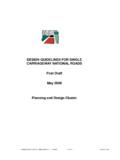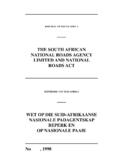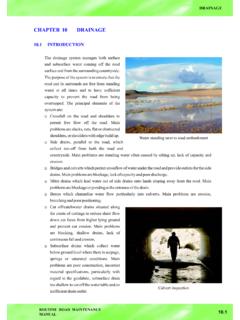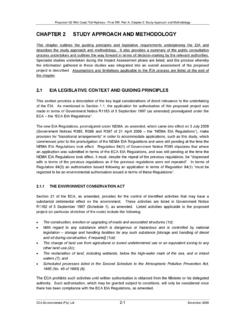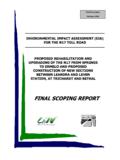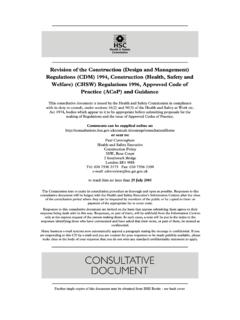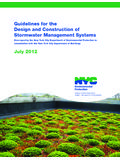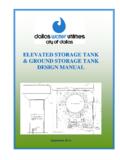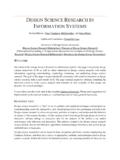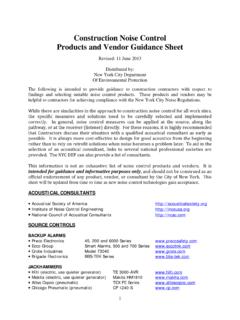Transcription of Draft TRH 20 THE STRUCTURAL DESIGN, …
1 TECHNICAL RECOMMENDATIONS FOR HIGHWAYS Draft TRH 20 THE STRUCTURAL design , construction AND maintenance OF UNPAVED ROADS 1990 ISBN 0 908381 87 5 Pretoria, South Africa, 1990 Published by Department of Transport P O Box 415 PRETORIA 0001 Republic of South Africa for the Committee of State Road Authorities PRINTED FEBRUARY 1990 Printed in the Republic of South Africa by V & R Printing Works (Pty) Ltd. PRETORIA PREFACE TECHNICAL RECOMMENDATIONS FOR HIGHWAYS (TRH) are written for the practising engineer and describe current, recommended practice in selected aspects of highway engineering. They are based on South African experience and on the results of research and have the full support of the Committee of State Roads Authorities (CSRA).
2 This document has been written by Dr P Paige-Green of the Division of Roads and Transport Technology under the guidance of a subcommittee of the Highway Materials Committee consisting of: Prof A T Visser University of Pretoria, Pretoria (Chairman) Mr N van der Walt DOT, Pretoria Mr G D van Zyl TPA, Pretoria Mr A Thompson NPA, Pietermaritzburg Mr E de Villiers CPA, Cape Town Mr J du Pisani OFSPA, Bloemfontein Mr S Poolman SWA DOT, Windhoek Mr T van Niekerk DBSA, Halfway House Mr P A Pienaar Jordaan and Joubert, Pietersburg. To confirm its validity in practice, it will be circulated in Draft form for a trial period before being submitted to the CSRA for approval. During this period you are welcome to send suggestions for improvement to the Chief Materials Engineer: Department of Transport, P O Box 415, Pretoria, 0001 or The Director, DRTT-CSIR, P O Box 395, Pretoria 0001.
3 Eventually a revised document, approved by the CSRA, will be issued as a full TRH in both languages. SOME NEW DEFINITIONS Grading coefficient (Gc) = ((per cent passing 26,5 mm per cent passing 2,0 mm) x per cent passing 4,74 mm)/100 Oversize index (Io) = per cent retained on 37,5 mm sieve Plastic factor (PF) = product of plastic limit and per cent passing 0,075 mm sieve (PL x P0,075) Shrinkage product (Sp) = Bar linear shrinkage from liquid limit x per cent passing 0,425 mm sieve CONTENTS 1 Basic economic 2 TYPICAL UNPAVED ROAD Impassibility (trafficability)..14 Gravel Excessive loose 3 design OF UNPAVED Geometric Thickness Minimum thickness required for subgrade protection (t).
4 15 Traffic induced compaction (Ct)..16 Predicted annual gravel loss (GLp x Ld)..16 Material Rural Urban Haul 4 Subgrade Gravel Wearing course Finish and Surface Subsurface 5 maintenance Levels of Practical aspects of Roadside Drainage Surface Safety Cost effectiveness of 6 REHABILITATION AND 7 ECONOMIC APPENDIX A : Recommended test method for the grading analysis of unpaved road wearing course materials 34 1 2 A suitable A 37,5 mm sieve, recommended diameter 450 The following sieves, 200 mm in diameter, complying with the requirements of SABS 197 (sieves larger than 4,75 mm must be of perforated plate and sieves 4,76 mm and smaller of woven wire mesh).
5 26,5 mm, 19,0 mm, 13,2 mm, 6,7 mm, 4,75 mm, 2,0 mm, 0,425 mm and 0,075 mm together with a bottom pan and A mechanical sieve shaker (optional)..35 A balance with a pan to weigh up to 25 kg, accurate to 5 A balance with a pan to weigh up to 5 kg, accurate to 1 A suitable basin about 450 mm in A pan about 300 mm Flat pans about 200 mm in diameter and 30 cm A drying oven, thermostatically controlled and capable of maintaining a temperature of 105 to 110 C. 35 The following brushes for cleaning the sieves: a brass or wire brush measuring approximately 50 mm x 25 mm with bristles not more than 25 mm long, and hard-bristle brushes measuring approximately 50 mm x 25 A 150 mm nominal diameter iron mortar and pestle and a rubber-tipped 3 Size of bulk Oversize 4 Calculate the mass of the -0,075 mm material by subtracting the total mass of the material retained on the sieves from the mass of the original test sample (see ).
6 36 Convert the mass of each fraction retained between two sieves to a percentage of the total dry mass of the test sample (see only the fraction smaller than 37,5 mm)..36 Convert the percentages retained on the sieves to percentages passing the Calculate the percentages to the nearest 0, Calculate the Oversize index as the mass of sample retained on the 37,5 mm sieve as a percentage of the total mass of the original dried bulk 5 The washing procedure for samples containing a high percentage of -0,075 mm material may be facilitated by dry sieving the sample prior to Table 2 gives the maximum allowable mass of material retained on a specific sieve 200 mm in diameter. To prevent overloading of a sieve, the material should be divided and sieved in more than one APPENDIX B : BASIC listing of model to predict annual gravel loss and regravelling APPENDIX C : BASIC listing of model to predict change in roughness with time and blading frequency39 APPENDIX D : Check-list of maintenance management input LIST OF FIGURES FIGURE 1 The forced oscillation theory for the formation of corrugation.
7 (After Heath and Robinson, 1980)..10 FIGURE 2 Examples of loose and fixed FIGURE 3 Relationship between shrinkage product, grading coefficient and performance of unpaved wearing course FIGURE 4 Ditches and FIGURE 5 Relationship between average road roughness and total vehicle operating LIST OF TABLES TABLE 1 Recommended material specifications for unpaved rural TABLE 2 Recommended material specifications for unpaved roads in urban TABLE 3 Recommended material specifications for unpaved haul TABLE 4 Definition of levels of Appendix A Table 1: Approximate mass of bulk and test Appendix A Table 2: Maximum allowable mass on 1 INTRODUCTION Background The economic well-being of a country is closely related to the state of its road network.
8 The agricultural, mining, forestry and tourist industries of all countries rely heavily on an adequate network of all-weather roads for their economic viability. The future development of most third-world countries is fundamentally dependent on the existence of adequate road networks. Unpaved roads are the major component of the road network in most developing countries and comprise a significant portion of the network even in highly developed countries such as the United States. It is unlikely that the overall percentage of unpaved roads will decrease significantly in the foreseeable future and techniques for improving the unpaved road networks are thus becoming increasingly important.
9 Many unpaved roads are presently designed with very little scientific input and are constructed from the nearest available material. Minimal attention is directed towards providing an adequate formation or effective drainage, or towards selecting suitable material for the prevailing conditions. Minimal maintenance is the norm in most developing areas. It is generally acknowledged, however, that worthwhile benefits can be obtained from an appropriate level of engineering input (Ferry, 1986). This TRH provides guidelines for the STRUCTURAL design , construction and maintenance of unpaved roads. It identifies design and construction techniques which will result in roads of a higher standard without the need for additional funds, makes recommendations for improving the management of unpaved road maintenance and discusses a number of appropriate maintenance techniques.
10 Aspects such as the planning of unpaved road networks and the geometric design are considered to be beyond the scope of this manual and are not discussed in any detail. These are covered in greater detail in DRTT (1989). Definitions Unpaved roads may be divided into earth tracks, earth roads or gravel roads. Earth tracks are the simplest low volume roads and generally consist of parallel ruts separated by vegetation, delineating a rural access route. These tracks are not engineered and are often impassable during or after wet weather conditions. In most cases they carry less than about five vehicles per day. They are usually used as local access roads by private land owners and small communities and are not normally constructed or maintained by a recognised road authority.
